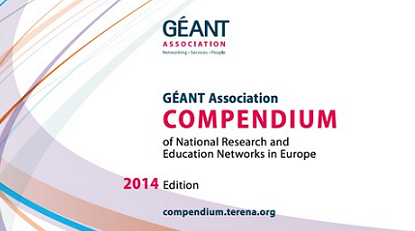News
2014 Compendium shows positive trends
 The fourteenth annual GÉANT Association Compendium of National Research and Education Networks (NRENs) in Europe is now available. The Compendium documents the work currently being done by NRENs, examining the different contexts in which they operate and explaining important trends in research and education networking that concern them.
The fourteenth annual GÉANT Association Compendium of National Research and Education Networks (NRENs) in Europe is now available. The Compendium documents the work currently being done by NRENs, examining the different contexts in which they operate and explaining important trends in research and education networking that concern them.
It’s an authoritative reference work for policy makers, funders, NRENs and their users.This year’s edition once more shows some interesting trends:
Trend 1: Increasing capacity
NRENs offer national backbones and international connectivity of exceptional quality. In most GÉANT partner countries, the typical core capacity is now 10 Gb/s, though some NRENs have reached 100 Gb/s. Germany is planning to upgrade to Terabit capacity, whereas some NRENs deploy several paths in their backbone, effectively increasing the capacity even further. For the first time since the inception of the Compendium, NRENs have reported that users are experiencing no congestion at the backbone level. For universities within the GÉANT region, the typical connection capacity is now above 1 Gb/s — a tremendous increase compared with the situation a few years ago.
Trend 2: Growth of eduGAIN and eduroam
Another positive development is that most of the GÉANT partner NRENs (and a number of non-GÉANT NRENs) have now joined or are planning to join the eduGAIN interfederation service — a development that holds the promise of worldwide service access across federations. Over the past year, eduroam has also shown remarkable growth. It is now available not only in all GÉANT countries but also in a growing number of other countries and territories. The number of locations with eduroam availability grew by 25% and the number of authentications more than tripled between January 2013 and January 2014; by September 2014, it was approaching 150 million per month.
Trend 3: Increased cost reductions
The overall trend, as in the past few years, is that each year NRENs are able to deliver more bandwidth and more services for roughly the same amount of money as in the previous year.
Further information
The GÉANT Association Compendium production is overseen by an international review panel and staff at the GÉANT Association Amsterdam office (formerly TERENA), and is financially supported by the European Union through the GN3plus (GÉANT) project. As in 2013, this 2014 edition of the Compendium is the product of a global collaboration effort that led to an NREN Common Information Model, which is now being used by regional NREN associations around the world.
To read up on the all of the findings and new statistics and developments in the 2014 Compendium (pdf), or access the full details of all NREN survey responses via the Compendium web page.
Printed copies of the Compendium will be sent to participating organisations, GÉANT Association members and policy makers. Additional copies are €25, excluding postage and can be ordered from the GÉANT Association's Amsterdam office: secretariat@terena.org.




